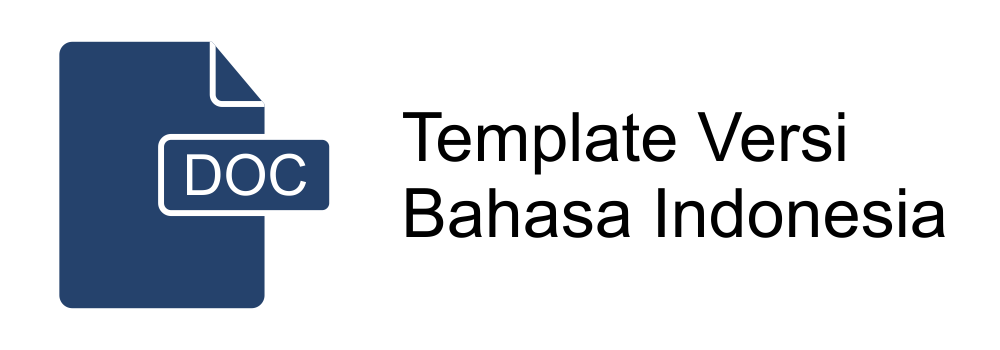Tingkat Keterbacaan Wacana pada Buku Teks Bahasa Indonesia Kurikulum Merdeka
Abstract
Indonesian language learning requires students to develop process skills. One of the process skills that must be mastered is the ability to complete a fill-in-the-blank test. The ability to complete a fill-in-the-blank test is very important because it can provide quantitative information that is easy to understand. The skill of reading or completing a fill-in-the-blank test in the form of verbal and nonverbal sentences is very necessary, especially in the field of Indonesian language. This study aims to determine the level of discourse readability in the Indonesian language textbook Class X Independent Curriculum. This research is descriptive research with a quantitative approach. This research was conducted by measuring the readability of discourse based on thecloze technique. The text tested was the text of the observation report in the grade X Indonesian language book published by the Ministry of Education and Culture revised 2021. The results showed that the highest percentage of text readability level categories was the easy category (independent) as many as 67.5% or 81 students, the medium category (instructional) 20.8% or 25 students and the difficult category (frustration) 11.7% or 14 students. The right choice of words (diction) and the application of simple sentence structures (simplex) make it easy for students to understand the content of the text. Thus, the observation report text is suitable to be applied at grade X level.
Keywords
Full Text:
PDFReferences
Anisa, N. V., Tandililing, E., & Mahmuda, D. (2017). Hubungan Kemampuan Siswa Menginterpretasikan Grafik dan Kemampuan Menyelesaikan Soal Gerak Lurus di SMP. Jurnal Pendidikan Dan Pembelajaran Khatulistiwa, 6(6), 18. https://doi.org/10.26418/JPPK.V6I6.20281
Erviani, F. R., Sutarto, & Indrawati. (2016). Model Pembelajaran Instruction, Doing, dan Evaluating (MPIDE) Disertai Resume dan Video Fenomena Alam dalam Pembelajaran Bahasa Indonesia di SMA. Jurnal Pembelajaran Bahasa Indonesia, 5(1), 5359.
Fadilah, R. (2016). Buku Teks Bahasa Indonesia SMP dan SMA Kurikulum 2013 Terbitan Kementerian Pendidikan dan Kebudayaan 2014. Jurnal Pena Indonesia, 1(1), 2649. https://doi.org/10.26740/jpi.v1n1.p26-49.
Fatin, I. (2017). Keterbacaan Buku Teks Bahasa Indonesia Kelas X Kurikulum 2013 Edisi Revisi 2016 dengan Formula Fry. Belajar Bahasa: Jurnal Ilmiah Program Studi Pendidikan Bahasa dan Sastra Indonesia, 2(1), 21-33.
Ginanjar, A. A. (2020). Analisis tingkat keterbacaan teks dalam buku ajar bahasa indonesia. Literasi: Jurnal Bahasa dan Sastra Indonesia serta Pembelajarannya, 4(2), 158-163.
Kurniawan, R. M., & Aprodita, F. (2020). Analisis Keterampilan Berpikir Kritis Mahasiswa pada Materi tes isian rumpang. Jurnal Kependidikan Betara, 1(2), 6373. https://doi.org/10.48109/JKB.V1I2.23
McKenzie, W. (2005). Multiple Intelligences and Intructional Technology. Washington: International Society for Technology in Education.
Muliana, E., Saminan, & Wahyuni, A. (2017). Gaya Berpikir Siswa dalam Menganalisis Konsep Bahasa Indonesia melalui tes isian rumpang. Jurnal Ilmiah Mahasiswa, 2(2), 264271.
Ningsih, S. M., S, B., & Sopyan, A. (2012). Implementasi Model Pembelajaran Process Oriented Guided Inquiry Learning (POGIL) untuk Meningkatkan Kemampuan Berpikir Kritis Siswa. Unnes Physics Education Journal, 1(2), 4452.
Nugraha, A., Darsikin, & Saehana, S. (2017). Kesulitan Siswa dalam Menyelesaikan Permasalahan tes isian rumpang. Ejournal.Unsri.Ac.Id.
Priyatni, E. T. (2014). Desain pembelajaran bahasa Indonesia dalam kurikulum 2013. Jakarta: Bumi Aksara.
Rini, D. P., Rahayu, P. A., Siwi, R. S., Fitriana, Z., Utomo, A. P. Y., & Wardani, O. P. (2023). Analisis Penggunaan Kalimat pada Teks Laporan Hasil Observasi dalam Buku Ajar Kelas X SMA Kurikulum Merdeka. Jurnal Pendidikan dan Ilmu Sosial, 1(2), 140-156.
Sukenti, D., Tinambunan, J., & Mukhlis, M. (2021). Studi Fenomenologi: Penilaian Membaca dalam Pembelajaran Bahasa Indonesia di Sekolah Menengah Atas Pekanbaru. GERAM, 9(2), 117-128.
Supardi, S. U. S., Leonard, L., Suhendri, H., & Rismurdiyati, R. (2015). Pengaruh Media Pembelajaran dan Minat Belajar Terhadap Hasil Belajar Bahasa Indonesia. Formatif: 2(1). https://doi.org/10.30998/FORMATIF.V2I1.86
Wahyuni, I., Wahyuni, I., & Lubis, K. I. (2012). Pengaruh Strategi Pembelajaran Berbasis Kecerdasan Visual Spasial terhadap Hasil Belajar Siswa pada Materi Gerak Lurus di Kelas VII SMP Negeri 2 Stabat. Jurnal Pendidikan Bahasa Indonesia, 1(2), 3742. https://doi.org/10.22611/jpf.v1i2.3185
Yasinta, I. N., Saleh, M., & Usman, U. (2020). Level Keterbacaan Buku Teks Bahasa Indonesia: Analysis Faktor Gender. Nuances of Indonesian Language, 1(2), 61-70.
Yaumi, M. (2013). Pembelajaran Berbasis Multiple Intelegences. Jakarta: Dian Rakyat.
DOI: https://doi.org/10.51817/nila.v5i2.1081
Refbacks
- There are currently no refbacks.

This work is licensed under a Creative Commons Attribution-NonCommercial-ShareAlike 4.0 International License.
NUANCES OF INDONESIAN LANGUAGE is indexed by:
This work is licensed under a Creative Commons Attribution-ShareAlike 4.0 International License.
REDAKSI
Nuances of Indonesian Language has been covered by the following services
Published by Perkumpulan Pengelola Jurnal Bahasa dan Sastra Indonesia serta Pengajarannya.
Apartemen Suite Metro
Jalan Soekarno Hatta No. 698B, Kelurahan Jatisari - Kecamatan Buahbatu Bandung, Jawa Barat 40286




.png)









